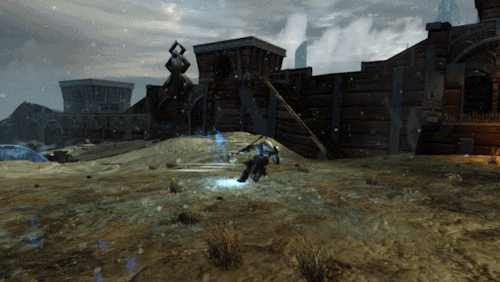Read full article
here...
To begin this blog post, let me pose a question: How do you measure the success of an MMO?
Historically, it’s been easy to point to success with traditional MMOs: subscription numbers were the ultimate means a company used to measure how well a game was doing, and customers typically looked at those same numbers as well to gauge the success of the game. The number of concurrent users—how many players are online at a given time—was also important, but that number was usually hidden from users, since it typically painted a less rosy picture of a game’s health when compared to the number of active subscriptions.
Now let me pose a second question: If the success of a subscription-based MMO is measured by the number of people paying a monthly fee, how does that impact game design decisions?
The answer can be found in the mechanics and choices made in subscription-based MMOs, which keep customers actively playing by chasing something in the game through processes that take as long as possible. In other words, designers of traditional MMOs create content systems that take more time to keep people playing longer. If this is your business motivation and model so you keep getting paid, it makes sense and is an incredibly smart thing to do, and you need to support it.
When your game systems are designed to achieve the prime motivation of a subscription-based MMO, you run the risk of sacrificing quality to get as much content in as possible to fill that time. You get leveling systems that take insane amounts of grind to gain a level, loot drop systems that require doing a dungeon with a tiny chance the item you want can drop at the end, raid systems that need huge numbers of people online simultaneously to organize and play, thousands of wash/repeat item-collection or kill-mob quests or dailies with flavor text support, the best stat gear requiring crazy amounts of time to earn, etc.
But what if your business model isn’t based on a subscription? What if your content-design motivations aren’t driven by the need to create mechanics that keep people playing as long as possible? When looking at content design for Guild Wars 2, we’ve tried to ask the question: What if the development of the game was based on…wait for it…fun?
...
his metric of success impacted a lot of our early content-related design decisions for Guild Wars 2. Some examples include:
- Fun impacts loot collection. The rarest items in the game are not more powerful than other items, so you don’t need them to be the best. The rarest items have unique looks to help your character feel that sense of accomplishment, but it’s not required to play the game. We don’t need to make mandatory gear treadmills, we make all of it optional, so those who find it fun to chase this prestigious gear can do so, but those who don’t are just as powerful and get to have fun too.
- Fun impacts decisions. Every time you finish a dungeon you get tokens you can trade in for reward items that you want, rather than having a small chance of getting it as a drop, because it’s more fun to always get rewarded for finishing with something you want to have!
- Fun impacts development. Explorable dungeons have multiple paths you can take and random events. Because of this you don’t feel like you need to play the same dungeon over and over again if you want to chase the prestigious rewards at the end, but can instead mix up that experience to keep it fresh and fun.
- Fun impacts customization. The event and personal story systems allow you to get a sense of customization from your characters. Playing through the game, each character can experience completely different content, and the world can always stay fresh and new in the pursuit of new story lines, and an ever-changing dynamic event world. It means going back to a place you’ve already been with a character can be fun, and it means making a new character on an entirely different personal story chain can be fun as well.
- Fun impacts gameplay. The pursuit of fun in content led us to make many gameplay decisions, including:Everyone who helps kill a creature gets experience and loot, so you’re not competing with other players; everyone gets rewarded for events with karma they can spend to buy rewards they want, rather than get a random roll of stuff they might not want; content scales in difficulty, so if more people show up, there is still stuff for you to do; everyone is able to revive one another, so you view other players as assets that can help you achieve your goals, rather than people who might get in your way; everyone can harvest resource nodes and get the rewards in the world together, rather than racing other people to them who might steal it from you. All of these things are just more fun!
...








 11:08 AM
11:08 AM
 Unknown
Unknown






